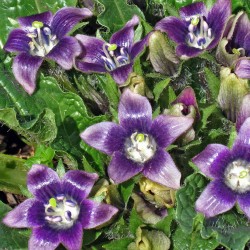Menu
-
Menuالعدمة
- Home
-
التصنيفات
-
-
التصنيفات
-
بذور الخضروات
-
أصناف حسب البلد
- أصناف من أرمينيا
- أصناف من البوسنة والهرسك
- أصناف من كرواتيا
- أصناف من فرنسا
- أصناف من ألمانيا
- أصناف من اليونان
- أصناف من المجر
- أصناف من الهند
- أصناف من إيطاليا
- أصناف من اليابان
- أصناف من شمال مقدونيا
- أصناف من بيرو
- أصناف من روسيا
- أصناف من صربيا
- أصناف من سلوفينيا
- أصناف من اسبانيا
- أصناف من تايلاند
- أصناف من تركيا
- أصناف من الولايات المتحدة الأمريكية
- بذور الطماطم
- بذور الذرة
- عائلة القرع
- الفول الأسرة
- بذور الخيار
- بذور الفلفل
- عائلة الجزرة
- عائلة البصل
- بذور الخس
- عائلة البطاطس
- عائلة الملفوف
- بذور الفجل
- عائلة الشمندر
- بذور البطيخ
- بذور بطيخ
- بذور القرنبيط
- عائلة عباد الشمس
-
أصناف حسب البلد
- بذور الفاكهة
- بذور الفلفل الحار
- بذور عشبة طبية
- تسلق بذور النباتات
- الأشجار - بذور بونساي
- بذور النخيل
- بذور الأعشاب الزينة
- بذور التبغ
-
بذور الخضروات
-
-
-
-
- منتجات جديدة
- التسليم - الدفع
- انشئ حساب
- FAQ
Last Product Reviews
These peppers came all the way from eastern Europe and took a while at no f...
By
 Fitim Berani on 21/09/2023
Fitim Berani on 21/09/2023
Verified Purchase
Last customers
- Stef, Waalwijk, Netherlands
- Dušan, KRAVANY NAD DUNAJOM, Slovakia
- Arno, Ehrenkirchen, Germany
- Costas, LARNACA , Cyprus
- Fulvio francesco, Santa Domenica Talao, Italy
- william, Dun, France
- Aymeric , Saint tricat, France
- Ricard, Sant Celoni, Spain
- Maureen, Enniscorthy Co Wexford , Ireland
- Paul, St. Vigil in Enneberg (BZ), Italy
- Ricardo jorge , Viseu , Portugal
- Radosav, Kragujevac, Serbia
- Sylvie, Neyruz, Switzerland
- Julien, Scionzier, France
- Zoran, Vinca, Serbia
- Josef, Hochdorf-Assenheim, Germany
- Davide, London, United Kingdom
- Kimberly, Victoria, Gozo, Malta
- Saša , Beograd, Serbia
- Ewa, Galway, Ireland
- Ioannis , Kato Achaia, Greece
- Samuele, Milano, Italy
- Dubravka, Niš , Serbia
- Theodoros, Grevena, Greece
- goderis, bredene, Belgium
- Vickie, SARONA, United States
- Maria, ÓBIDOS / LEIRIA, Portugal
- Emmanuel, Dijon, France
- Henri , Koumac, New Caledonia
- Manuel , Mülchi, Switzerland
يوجد 170 منتجا.
عرض 145-156 من 170 منتجات
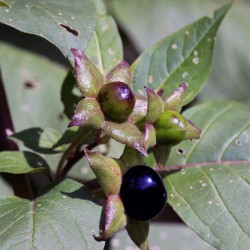
ست الحسن بذور
السعر
3.75 €
SKU: MHS 58
Seeds Gallery Com,
5/
5
<!DOCTYPE html>
<html>
<head>
<meta http-equiv="Content-Type" content="text/html; charset=UTF-8" />
</head>
<body>
<h2><strong>ست الحسن بذور</strong></h2>
<h2><span style="color: #ff0000;"><strong>ثمن عبوة من 5 بذور.</strong></span></h2>
<p>نبات<span> </span><b>ست الحسن</b>،<span> </span><b>أتروبا بيلادونا، أتروبا بيلا-دونا، بيلادونا أو الباذنجان المميت</b><span> </span>هي نبتة عشبية معمرة من العائلة الباذنجانية، يرجع أصلها إلى<span> </span>أوروبا،<span> </span>أفريقيا<span> </span>الشمالية، آسيا الغربية، وبعض المناطق في<span> </span>كندا<span> </span>والولايات المتحدة الأمريكية. يصل ارتفاع هذه الشجيرة إلى متر ونصف المتر ذات أوراق كبيرة بيضاوية الشكل، وأزهارها قمعية على شكل جرس بلون مخضر إلى بنفسجي، ثمارها على هيئة عنبات ذات لون أسود والنبات دائم الخضرة، يعرف النبات باسم البلادونا<span> </span><b>Belladonna</b><span> </span>يعرف علمياً باسم<span> </span><b>Atropa Belladonna</b><span> </span>من فصيلة الباذنجانية. وجذور النبات على شكل<span> </span>الكلية<span> </span>بنية اللون الجزء المستخدم من نبات ست الحسن: الأوراق والساق والجذور. وهي تحتوي على العديد من العناصر الفعالة صيدلانيا" وأهمها هو الأتروبين Atropin الذي يمتلك خواص عديدة أهمها هو توسيع الحدقة في العين والهيوسيامين hyoscyamine الذي يملك خواص مضادة للتشنج بالنسبة للعضلات الملساء وقد تم تخليق المادتين بشكل صنعي ويتم استخدامهما حاليا" في الصناعة الدوائية.</p>
<p>لدى هذه النبتة تاريخ طويل كدواء، كمادة تجميلية وكسم. قبل العصور الوسطى، كانت تستخدم الاتروبين كوسيلة<span> </span>تخدير<span> </span>في العمليات: استخدمها<span> </span>الرومان<span> </span>القدماء كسم (زوجة الإمبراطور اوغسسطس وزوجة كلوديوس كلاهما كان يشاع أنهما استخدمتاها للقتل): وسبق ذلك استخدامها لصنع رؤوس السهام المسمومة. النوع وهو أتروبا جاء من كلمة اتروبوس، الذي يعتبر واحد من ثلاثة اقدار في علم الاساطير، والاسم " بيلا-دونا" مشتق من اللغة الإيطالية ويعني " المرأة الجميلة " لان العشبة كانت تستخدم كقطرة للعين من النساء لتوسيع حدقة العين كي تبدو أكثر جاذبية.</p>
<p>أصل التسمية<br />جاء اسم الجنس Atropa من الإلهة الإغريقية أتروبوس إلهة القدر والمصير في الميثولوجيا الإغريقية. أما كلمة bella dona فقد جاءت من الإيطالية وتعني "المرأة الجميلة" وذلك لأن هذه العشبة كانت تستعمل في قطرات العين لدى النساء لتوسيع بؤبؤ العين، لجعلهن يبدين أكثر جاذبية. الاسم أتروبا بيلادونا نشره لينياس في كتاب "أصناف النبات " في عام 1753. في عائلة " ظل الليل" (الباذنجانيات). والتي تتشارك مع البطاطا، البندورة، الباذنجان،التبغ،الفلفل الأحمر، الحضض (عوسج)و عشبة جيمسون(الداتورا الصفراوية). الأسماء الشائعة لهذه الاصناف هي بيلادونا، الباذنجان القاتل، ديفال، أوراق البلادونا(dwale)، توت الشيطان، كرز الرجل المشاغب، كرز الموت، الموت الجميل، عشبة الشيطان، موريل الكبير (و هو نوع من أنواع الفطر)، كرز دواي .</p>
<p>ويعتقد أن اسم أتروبا مشتق من الإلهة اليونانية أتروبس، واحدة من ثلاث من المصائر اليونانية ثلاثة التي تحدد مسار حياة الإنسان عن طريق نسج الخيوط التي ترمز إلى ولادته، والأحداث في حياته، وأخيرا وفاته، حيث تستخدم النبتة لقطع هذه الخيوط عند وفاته ."البلادونا" تأتي من اللغة الإيطالية، وتعني "سيدة جميلة"؛والتي نشأت إما من استخداماته كمستحضرات تجميل للوجه، أو ربما من جراء استخدامه لزيادة حجم حدقة العين في النساء.</p>
<p>الموطن الأصلي للنبات<br />الموطن الأصلي أوروبا وغربي أسيا في سوريا وشمال أفريقيا. يكثر نموها في الأراضي الجيرية في مصر ومناطق عديده في أسيا.تُجنى الأوراق في الصيف، أما الجذور من السنة الأولى فما فوق في فصل الخريف.</p>
<p>الوصف</p>
<p>أتروبا بيلادونا نبتة عشبية متفرعة ومعمرة، غالبا تنمو كشحيرة بجذور سميكة. هذه النباتات تنمو بطول 1.5 متر (4,9 قدم) وأوراقها بيضوية الشكل ويبلغ طولها 18 سم (7,1 انش). شكل زهورها كالجرس ولونها بنفسجي بمسحة خضراء ورائحة ضعيفة. فاكهة النبتة هي التوت، ذات لون أخضر، وعندما تنضج يتحول لونها إلى الأسود اللامع ويبلغ قطرها تقريبا 1 سم (0.39 انش). التوت حلو المذاق ويتغذى عليه الحيوانات اللتي تساعد في نشر البذور عن طريق التبرز، على الرغم أن البذور تحتوي على قلويدات سامة. هنالك نوع يحتوي على الأزهار صفراء شاحبة لللون التي تسمى أتروبا بيلادونا فار-لوتيا مع فاكهة صفراء شاحبة أيضا. أتروبا بيلادونا نادرا ما تسنخدم في الحدائق، ولكن عندما تنمو تستخدم غالبا لكونها مستقيمة وضخمة وتوتها المبهرج. وهي تزرع في عدة مناطق في أمريكا الشمالية، حيث أنها غالبا توجد في المناطق المظللة والرطبة في التربة الغنية بالحجر الكلسي. هذه النبتة تعتبر نوع من أنواع الاعشاب في بعض مناطق العالم حيث أنها تستوطن المناطق ذات التربة المضطربة. انبات البذور الصغيرة عادة ما يكون صعبا بسبب صلابة اغلفة البذور التي تسبب خمود البذور.الإنبات عادة ما ياخذ عدة اسابيع تحت درجات حرارة متغيرة، ولكن يمكن تسريع العملية من خلال استخدام حمض الجبريليك. الشتلات تحتاج تربة معقمة حتى تمنع الاضطرابات الجذرية خلال عملية الزرع. هذه النبتة تدل على وجود الماء بالقرب منها.</p>
<p>السُمّية<br />نبات ست الحسن هو أحد أكثر النباتات سمية في الشرق.، تحتوى جميع أجزاء النبات على القلويدات. وتشكل الثمار خطرا على الأطفال لأنها جذابة طعمها حلو نوعا ما.</p>
<p>إن أكل ثمرتين إلى 5 ثمرات من ست الحسن من قبل رجل بالغ قد يسبب الموت، وعموما فان جذر النبات هو الأكثر سمية على الإطلاق رغم أن هذا قد يختلف من عينة لأخرى، وابتلاع ورقة واحدة من النبات يسبب موت شخص بالغ.</p>
<p>البلادونا هي واحدة من أكثر النباتات السامة الموجودة في نصف الكرة الشرقي. جميع أجزاء هذه النبتة تحتوي على قلويدات التروبان. حيث يشكل التوت أكبر خطر على الأطفال لأنه يبدو جذاب وله طعم حلو نوعا ما. ان استهلاك 2-5 من التوت من قبل الكبار قاتل. ان جذر هذا النبات بصفة عامة هو الجزء الأكثر سمية، وإن كان هذا يختلف من نوع إلى آخر. ان ابتلاع ورقة واحدة من النبات يمكن أن تكون قاتلة لشخص بالغ.</p>
<p>المواد الفعالة في البلادونا، الأتروبين، هيوسين (سكوبولامين)، والهيوسيامين، لها خصائص مضادات الكولين.<br />أعراض التسمم في البلادونا تشمل اتساع حدقة العين، الحساسية ضد الضوء، عدم وضوح الرؤية، عدم انتظام دقات القلب، فقدان التوازن، الترنح، الصداع، الطفح الجلدي، الاحمرار، جفاف الفم والحلق الشديد، فقدان القدرة على الكلام بسهولة، احتباس البول، الإمساك، الارتباك، الهلوسة، ولهذيان، والتشنجات. وفي عام 2009، تناولت امرأة راشدة توت البلادونا عن طريق الخطأ بدلا من التوت العادي. وقد تم توثيق تناولها لستة حبات من التوت أنها تؤدي إلى متلازمة مضادات الكولين الشديدة. حيث أن سبب الأعراض القاتلة سببه الأتروبين الذي حد من قدرة الجهاز العصبي المسؤول عن الراحة وهضم الطعام من تنظيم الاوامر اللارادية، مثل التعرق، التنفس، وتنظيم معدل ضربات القلب. الترياق للتسمم في البلادونا هو الفيزوستيغمين أو البيلوكاربين، وهو نفس الترياق للتسمم بالأتروبين. البلادونا أيضا سامة للكثير من الحيوانات المحلية حيث تسبب الخدر والشلل. ومع ذلك، فان الماشية والأرانب تأكل من هذا النبات على ما يبدو دون أن تعاني آثار ضارة. اما في البشر، فان ذلك سوف يتسبب في اختلال القدرات الإدراكية، مثل الذاكرة والتعلم.</p>
<p>الاستخدامات<br />الاستخدامات التجميلية<br />منشأ اسم (بيلادونا) من استخدامه التاريخي من قبل النساء حيث بالإيطالية بيلادونا تعنى السيدة الجميلة. قطرات محضرة من نبتة ست الحسن كانت تستخدم لتوسعة حدقة أعين النسا مما يزيد من جاذبيتها. هذه القطرات تعمل كمضاد مسكاريني، تغلق المستقبلات في عضلة العين التي تسبب تضيق في الحدقة. حاليا نبتة ست الحسن نادرا ما تستخدم تجميليا لما تسببه من أعراض جانبية مثل اضطرابات قليلة في الرؤية، أو عدم القدرة على التركيز على الأجسام القريبة وزيادة ضربات القلب. استخدامها لفترة طويلة يسبب العمى.</p>
<p>الاستخدامات الطبية<br />تم استخدام البلادونا في طب الأعشاب لقرون باعتبارها مسكن للآلام، مهديء للعضلات، ومضادة للالتهابات، علاج مشاكل الدورة الشهرية، مرض القرحة الهضمية، رد الفعل الناتج عن الهيستامين، ودوار الحركة. حيث أوضحت مجلة الطب الانتقائي للقرن التاسع عشر كيفية تحضير مستحضر البلادونا لتناولها مباشرة من قبل المرضى. الصبغات، مستخلصات الغلي، المساحيق، وكذلك خليط املاح القلويدات، لا تزال تنتج للاستخدامات الصيدلانية، وغالبا ما يتم توحيد هذه المكونات في جميع المستحضرات بنسبة 1037 جزء هيوسيامين إلى 194 جزء اتروبين إلى 65 جزء سكوبولامين. وتوضع القلويدات مع الفينوباربيتال و/ أو الكاولين والبكتين للاستخدام في مختلف اضطرابات الجهاز الهضمي الوظيفية. الصبغة، تستخدم لأغراض مماثلة، لا تزال في معظم دساتير الأدوية، تستخدم مع صبغة مشابهة من الداتورة سترامونيوم بعد أن كانت في دستور الأدوية الأمريكي على الأقل حتى أواخر 1930. مزيج من البلادونا والأفيون، في مسحوق، أو على شكل صبغة، أو على شكل قلويد، مفيد بشكل خاص عن طريق الفم أو تحميلة للإسهال وبعض أشكال الألم الداخلية. ويمكن إجراء ذلك من قبل صيدلاني، وقد تكون متوفرة كتركيبة ثابتة في بعض البلدان (مثل: B & O Supprettes) وهي تركيبة سائلة بطعم الموز من البيلادونا والافيون كانت متاحة حتى 31 ديسمبر 1992 في الولايات المتحدة (Donnagel PG الاسم التجاري الأكثر شيوعا).<br />يستخدم السكوبولامين كملح الهيدروبروميد لشكاوى الجهاز الهضمي ودوار الحركة، كما يستخدم لتحفيز الادوية المسكنة وادوية ازالة القلق من المسكنات الأفيونية. كان يستخدم سابقا في مسكن للألم يسمى "نوم الشفق" أثناء الولادة. تستخدم كبريتات الاتروبين بمثابة موسعه للحدقة ومسببه لشلل العضلة الهدبية أثناء فحوصات العين. كما أنها تستخدم كترياق في حالات التسمم بالفوسفات العضوية والكاربامات، ويتم تحميلها في حاقن اتوماتيكي لاستخدامها في حال وقوع هجوم بغاز الأعصاب. المعالجة بالاتروبين (تناول جرعة كافية لمنع الآثار الناتجة عن غاز الأعصاب) حيث يتم تناوله إلى اغلاق 100 من مستقبلات ال muscuranic acetylcholine.كبريتات الاتروبين هي المعيار لقياس قوة الأدوية المضادة للكولين.</p>
<p>يستخدم الهيوسيامين مثل الكبريتات أو الهيدروبروميد لمشاكل الجهاز الهضمي ومرض الباركنسون. بالإضافة إلى ان اثارها الجانبية متوسطة بالنسبة للأتروبين والسكوبولامين، ويمكن أن يستخدم أيضا لمكافحة الآثار السامة الناتجة من الفوسفات العضوية. إن الهيوسيامين هو القلويد الأساسي في ال Asthmador، وهوعلاج بدون وصفة للتخفيف من الربو القصبي، الي حين تم وقف استخدامه . الأدلة العلمية التي توصي باستخدام البلادونا في شكلها الطبيعي لأي شرط غير كافية، على الرغم من أن بعض مكوناتها، ولا سيما الأتروبين التي تمت تنقيته من البلادونا في عام 1830، كانت مقبولة للاستخدام الطبي. Donnatal وهو أحد الأدوية الموصوفة طبيا التي وافقت عليها إدارة الغذاء والدواء في الولايات المتحدة الأمريكية، التي تجمع بين قلويدات البلادونا الطبيعة بنسبة محددة وثابتة مع الفينوباربيتال لتوفير تاثير مضادات الكولين الطرفية، مضادات التشنج وتخدير متوسط التاثير. وفقا للملصق فأنه من الممكن أن تكون فعالة لاستخدامها كعلاج مساعد في علاج متلازمة القولون العصبي (القولون العصبي، القولون التشنجي، التهاب القولون المخاطي) والتهاب الأمعاء الحاد.</p>
<p>الاستخدامات الطبية البديلة<br />وتستخدم مستحضرات البلادونا في المعالجة المثليةhomeopathy. أيضا في الاستخدام السريري والتجارب البحثية يعتبر المستحضر الأكثر شيوعا حيث يتم تخفيفه إلى 30 مرة في المعالجة المثلية. حيث لا يحتوي هذا المستوى من التخفيف أيا من النبات الأصلي على الرغم من ان المستحضرات التي تخفف مرات اقل والتي تحتوي احصائيا على كميات ضئيلة من النبتة يتم الإعلان عنها للبيع.</p>
<p>المخدرات الترفيهية او العقاقير المنشطة<br />نبتة البلادونا والنباتات ذات الصلة، مثل أعشاب جيمسون الضارة (داتورة سترامونيوم)، تستخدم كعقاقير منشطة بسبب الهلوسة القوية والهذيان التي تنتجها هذه النباتات. ومع ذلك، فان هذه الهلوسة غير سارة ويعتبر استخدام هذه النباتات لغايات ترفيهية في غاية الخطورة بسبب ارتفاع مخاطر تناول جرعة زائدة قاتلة عن غير قصد. وبالإضافة إلى ذلك، فإن الجهاز العصبي المركزي يتاثر بالأتروبين ويشمل ذلك تشوش الذاكرة، مما قد يؤدي إلى ارتباك شديد.</p>
<p>السم<br />و قد استخدمت قلويدات الأتروبا بيلادونا كنوع من أنواع السموم حيث استخدمها البشر في وقت مبكر لصناعة السهام المسمومة من النبات. وفي روما القديمة، كان يستخدم السم من قبل أغريبينا الصغرى، زوجة الإمبراطور كلوديوس بناء على مشورة من لوكستا، وهي سيدة متخصصة في السموم، وليفيا، التي يشاع أنه استخدمته لقتل زوجها الإمبراطور أوغسطس. أيضا استخدمه ماكبث من اسكتلندا، عندما كان لا يزال واحدا من مساعدي الملك دنكان الأول، حيث استخدمه خلال هدنة لتسميم القوات الغازية التابعة لهارولد هارفوت، ملك إنجلترا، لدرجة أن القوات الإنجليزية لم تكن قادرة على الوقوف على الأرض وكان عليهم الرجوع إلى سفنهم.</p>
<p>الفولكلور او الاستخدامات الشعبية<br />المواد الرئيسية: في الماضي، كان يعتقد السحرة ان استخدام مزيج من البيلادونا وخشخاش الأفيون وغيرها من النباتات، سامة (مثل ال monkshood وسم الشوكران)، كمرهم للتحليق يساعدهم على التحليق والتوجه إلى التجمعات مع السحرة الأخرى. وقد جادل كارلو غينسبورغ وغيره من الجهات إلى ان هذه المراهم تهدف إلى تشجيع الحلم الهلوسة.و ان التفسير المحتمل لإدراج البلادونا وخشخاش الأفيون في مراهم التحليق يتعلق بالتاثير العكسي بين قلويدات التروبان في البلادونا (تحديدا السكوبولامين) وقلويدات الأفيون في خشخاش الأفيون، الخشخاش المنوم (تحديدا المورفين)، التي تنتج حالة من الاستيقاظ تشبه الحلم. عرف هذا التاثير العكسي في الطب الشعبي، التي نوقشت في المستحضرات الموجودة في الطب الانتقائي.والتي شرحت كيف استخدمت المراهم في الكتابة المعاصرة على السحر. ان التاثير العكسي بين المواد الأفيونية والتروبان هو الأساس الأصلي الذي يعمل عليه "نوم الشفق" الذي تم توفيره للملكة فيكتوريا للقضاء على الألم، فضلا عن الوعي أثناء الولادة، والذي تم تعديله في وقت لاحق، واستخدمت القلويدات المعزولة بدلا من المواد النباتية. حيث أن عشب البلادونا له تأثيرات غير متوقعة من السمية .</p>
</body>
</html>
MHS 58 (5 S)


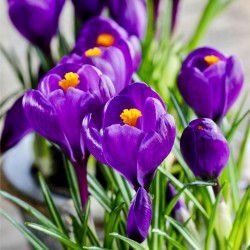
Purple Crocus bulbs
السعر
3.50 €
SKU: F 81 P
Seeds Gallery Com,
5/
5
<!DOCTYPE html>
<html>
<head>
<meta http-equiv="Content-Type" content="text/html; charset=UTF-8" />
</head>
<body>
<h2><strong>Purple Crocus bulbs</strong></h2>
<h2><span style="color: #ff0000;"><strong>The price is for package of 3 bulbs.</strong></span></h2>
<p><span style="font-size: 11pt; color: #000000; font-family: georgia, palatino;"><i><b><strong><span style="font-size: 12pt;">This variety is famous for its delightful fragrance. There's nothing like closing your eyes and breathing in the sweet scent of Spring! </span></strong></b></i></span></p>
<p><span style="font-size: 11pt; color: #000000; font-family: georgia, palatino;"><i><b>Crocus</b></i> (English plural: crocuses or croci) is a genus of flowering plants in the iris family comprising 90 species of perennials growing from corms. Many are cultivated for their flowers appearing in autumn, winter, or spring. The spice saffron is obtained from the stigmas of <i>Crocus sativus</i>, an autumn-blooming species. Crocuses are native to woodland, scrub, and meadows from sea level to alpine tundra in central and southern Europe, in particular Krokos, Greece<sup id="cite_ref-2" class="reference"></sup>, on the islands of the Aegean, North Africa and the Middle East, and across Central Asia to Xinjiang Province in western China.</span></p>
<p><span style="font-size: 12pt; font-family: georgia, palatino; color: #000000;">The cup-shaped, solitary, salverform flower tapers off into a narrow tube. Their colors vary enormously, although lilac, mauve, yellow, and white are predominant. The grass-like, ensiform leaf<sup id="cite_ref-10" class="reference"></sup> shows generally a white central stripe along the leaf axis. The leaf margin is entire.</span></p>
<p><span style="font-size: 12pt; font-family: georgia, palatino; color: #000000;">A crocus has three stamens, while a similar-looking toxic plant, <i>colchicum</i>, sometimes popularly referred to as "autumn crocus", has six stamens. In addition, crocus have one style, while <i>colchicum</i> have three.</span></p>
<p><span style="font-size: 12pt; font-family: georgia, palatino; color: #000000;">About 30 of the species are cultivated, including <i>Crocus sativus</i> for saffron production. The varieties cultivated for decoration mainly represent five species: <i>C. vernus</i>, <i>C. chrysanthus</i>, <i>C. flavus</i>, <i>C. sieberi</i>, and <i>C. tommasinianus</i>. Among the first flowers to bloom in spring, crocuses are popular with gardeners. Their flowering time varies from the late winter <i>C. tommasinianus</i> to the later large hybridized and selected Giant "Dutch crocuses" (<i>C. vernus</i>). Crocus flowers and leaves are protected from frost by a waxy cuticle; in areas where snow and frost occasionally occur in the early spring, it is not uncommon to see early flowering crocuses blooming through a light late snowfall.</span></p>
<h2><span style="color: #ff0000; font-size: 13pt; font-family: georgia, palatino;"><a href="https://www.seeds-gallery.shop/en/home/saffron-bulbs-saffron-crocus.html" target="_blank" title="Saffron Bulbs can be purchased here" style="color: #ff0000;" rel="noreferrer noopener"><strong>Saffron Bulbs can be purchased here</strong></a></span></h2>
</body>
</html>
F 81 P


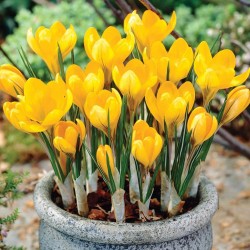
Yellow Crocus bulbs
السعر
3.50 €
SKU: F 81 Y
Seeds Gallery Com,
5/
5
<!DOCTYPE html>
<html>
<head>
<meta http-equiv="Content-Type" content="text/html; charset=UTF-8" />
</head>
<body>
<h2><strong>Yellow Crocus bulbs</strong></h2>
<h2><span style="color: #ff0000;"><strong>The price is for package of 3 bulbs.</strong></span></h2>
<p><span style="font-size: 11pt; color: #000000; font-family: georgia, palatino;"><i><b><strong><span style="font-size: 12pt;">This variety is famous for its delightful fragrance. There's nothing like closing your eyes and breathing in the sweet scent of Spring! </span></strong></b></i></span></p>
<p><span style="font-size: 11pt; color: #000000; font-family: georgia, palatino;"><i><b>Crocus</b></i> (English plural: crocuses or croci) is a genus of flowering plants in the iris family comprising 90 species of perennials growing from corms. Many are cultivated for their flowers appearing in autumn, winter, or spring. The spice saffron is obtained from the stigmas of <i>Crocus sativus</i>, an autumn-blooming species. Crocuses are native to woodland, scrub, and meadows from sea level to alpine tundra in central and southern Europe, in particular Krokos, Greece<sup id="cite_ref-2" class="reference"></sup>, on the islands of the Aegean, North Africa and the Middle East, and across Central Asia to Xinjiang Province in western China.</span></p>
<p><span style="font-size: 12pt; font-family: georgia, palatino; color: #000000;">The cup-shaped, solitary, salverform flower tapers off into a narrow tube. Their colors vary enormously, although lilac, mauve, yellow, and white are predominant. The grass-like, ensiform leaf<sup id="cite_ref-10" class="reference"></sup> shows generally a white central stripe along the leaf axis. The leaf margin is entire.</span></p>
<p><span style="font-size: 12pt; font-family: georgia, palatino; color: #000000;">A crocus has three stamens, while a similar-looking toxic plant, <i>colchicum</i>, sometimes popularly referred to as "autumn crocus", has six stamens. In addition, crocus have one style, while <i>colchicum</i> have three.</span></p>
<p><span style="font-size: 12pt; font-family: georgia, palatino; color: #000000;">About 30 of the species are cultivated, including <i>Crocus sativus</i> for saffron production. The varieties cultivated for decoration mainly represent five species: <i>C. vernus</i>, <i>C. chrysanthus</i>, <i>C. flavus</i>, <i>C. sieberi</i>, and <i>C. tommasinianus</i>. Among the first flowers to bloom in spring, crocuses are popular with gardeners. Their flowering time varies from the late winter <i>C. tommasinianus</i> to the later large hybridized and selected Giant "Dutch crocuses" (<i>C. vernus</i>). Crocus flowers and leaves are protected from frost by a waxy cuticle; in areas where snow and frost occasionally occur in the early spring, it is not uncommon to see early flowering crocuses blooming through a light late snowfall.</span></p>
<h2><span style="color: #ff0000; font-size: 13pt; font-family: georgia, palatino;"><a href="https://www.seeds-gallery.shop/en/home/saffron-bulbs-saffron-crocus.html" target="_blank" title="Saffron Bulbs can be purchased here" style="color: #ff0000;" rel="noreferrer noopener"><strong>Saffron Bulbs can be purchased here</strong></a></span></h2>
</body>
</html>
F 81 Y


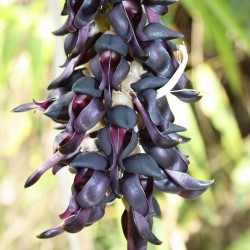
بذور عنب اليشم الأسود...
السعر
12.50 €
SKU: T 74 B
Seeds Gallery Com,
5/
5
<!DOCTYPE html>
<html>
<head>
<meta http-equiv="Content-Type" content="text/html; charset=UTF-8" />
</head>
<body>
<h2><strong>بذور عنب اليشم الأسود (موكونا نيجريكانز)</strong></h2>
<h2><span style="color: #ff0000;"><strong>ثمن حزمة من بذرة واحدة.</strong></span></h2>
<p>هذه كرمة مزهرة جميلة. تظهر أزهار البنفسج الداكن متماسكة معًا في مجموعات تشبه العنب ، يصل طولها إلى 30 سم وقطرها 15 سم. الزاحف الخشبي القوي جدًا - خلال الطقس الدافئ يمكن أن تنمو هذه الكرمة 60 سم أو أكثر في الأسبوع. يمكن أن يصل طول السيقان إلى 18 مترًا</p>
</body>
</html>
T 74 B

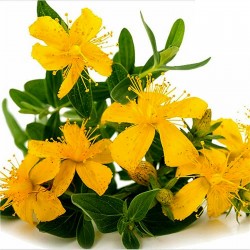
عرن مثقوب بذور
السعر
1.95 €
SKU: MHS 45
Seeds Gallery Com,
5/
5
<h2 dir="rtl"><strong>عرن مثقوب بذور</strong></h2>
<h2 dir="rtl"><span style="color: #ff0000;" class=""><strong>ثمن عبوة من 1000 (0.1g) بذرة.</strong></span></h2>
<p dir="rtl">العرن المثقوب وتعرف في الغرب باسم نبتة القديس يوحنا المثقبة، ونبتة القديس يوحنا الشائعة، ونبتة القديس يوحنا. هي نبتة مزهرة من جنس العرن، وتعتبر عشبة طبية لها فعالية ضد الاكتئاب، وخواص قوية مضادة للالتهابات بحيث أنها مانع لأنزيم أراكيدونيت 5-ليبوكسيجينيز ومانعة لأنزيم كوكس-1. تدعم الدراسات استخدام نبتة العرن المثقوب لعلاج الاكتئاب لدى الإنسان. في استعراض ل(29) تجربة سريرية عام 2008 من قبل تعاون كوتشرين، تم التوصل إلى أنها تتفوق على الدواء الوهمي في علاج المرضى الذين يعانون من الاكتئاب الشديد، بحيث أن النبات له نفس فعالية مضادات الاكتئاب وذو أعراض جانبية أقل. وحسب المركز الوطني للصحة التكميلية والتكاملية من المعاهد الوطنية للصحة، بالرغم من أن الدليل ليس حاسما، فإن النبتة قد تساعد في بعض أنواع الاكتئاب، كما أنها قد تقلل من فعالية الأدوية الموصفة، وقد تسبب اضطرابا عقليا ولكنه أثر جانبي نادر. كما نبَه المركز الوطني للصحة التكميلية والتكاملية إلى أن الاستخدام المتزامن لنبتة القديس يوحنا وبعض الأدوية المعينة قد يؤدي إلى حالة خطيرة تهدد بحياة الإنسان ويرتفع فيها مستوى الناقل العصبي سيروتونين "مادة كيميائية في الدماغ التي تستهدفها مضادات الاكتئاب". قد تكون النبتة سامة للخيول والأغنام والماشية إذا تم ابتلاعها بكميات كبيرة. كانت نبتة هايبيريكم بيرفراتم في الأصل تنمو في أوروبا، ولكنها انتشرت إلى جميع أنحاء العالم كصنف نبات غازي، بما في ذلك المناطق المعتدلة وشبه الاستوائية في تركيا، وأوكرانيا، وروسيا، والشرق الأوسط، والهند، وكندا، والولايات المتحدة، والصين.</p>
<p dir="rtl">النبتة ذات أزهار صفراء، لها سيقان تنمو بشكل أفقي ينمو منها نباتات جديدة، وهي نبتة معمرة كانت تنمو في أوروبا. وقد ظهرت في العديد من المناطق المعتدلة من العالم وتنمو بريا في كثير من المروج. الاسم الشائع للنبتة يأتي من اليوم التقليدي لإزهارها وحصادها في يوحنا المعمدان وهو يوم 24-6. اسم الجنس هايبيريكم مستمد من الكلمات اليونانية هايبر(وتعني فوق) وايكون(وتعني صورة), إشارةً إلى الاستخدام التقليدي للنبتة في درء الشر، عن طريق تعليقها فوق رمز ديني في المنزل في يوم القديس يوحنا. ويشير اسم الصنف بيرفراتم إلى الغدد الدهنية الصغيرة على الأوراق وهذه الغدد تشبه الشبابيك في شكلها، حيث يمكن ملاحظتهم عند حملها تجاه الضوء. نبتة القديس يوحنا هي نبتة معمرة ذات جذور زاحفة وتمتد لمساحة واسعة. لديها سيقان مستقيمة، تتشعب في الجزء العلوي، ويمكن أن تنمو إلى ارتفاع 1 متراً. ولديها أوراق مستطيلة ضيقة وبدون ساق، معارضة في اتجاهها لبعضها البعض قد يصل طولها إلى 1-2 ميليمتراً أو أكبر قليلاً. وهم ذو لون أصفر إلى أخضر بالإضافة إلى وجود نقاط شفافة في جميع أنحاء النسيج وأحيانا مع بعض النقاط السوداء على السطح السفلي . الأوراق تحمل نقاط شفافة واضحة عندما تحمل باتجاه الضوء، مما يعطيها مظهر مثقب، والذي استُمد منه الاسم اللاتيني للنبتة. يصل عرض أزهارها إلى 2.5 سنتيمتراً، ولها خمس بتلات ذات لون أصفر زاهي مع بقع سوداء واضحة. تظهر الزهور في سنمة واسعة في نهايات الأغصان العليا، وبين أواخر الربيع وأوائل إلى منتصف الصيف. سبلات الزهرة منقطة ويوجد نقاط غدية في الأنسجة.هنا كالعديد من الأسدية، التي تتحد في القاعدة إلى ثلاث حزم. حبوب اللقاح ذات شكل بيضاوي.</"ref name="Mehta> عندما يتم سحق براعم الزهور (وليس الزهور أنفسهم) أو البذرة، ويتم إنتاج سائل محمر / أرجواني.</p>
<p dir="rtl">تتكاثر نبتة القديس يوحنا جنسياً ولا جنسياً. وهي تزدهر في المناطق التي يسود فيها نمط هطول الأمطار صيفي أو شتوي، ومع ذلك التوزيع محدد بدرجات الحرارة المنخفضة لإنبات البذور أو لإبقاء الشتلات على قيد الحياة وتعتبر الارتفاعات التي أكبر من 1500 متر، وهطول الأمطار الذي أقل من 500 ملم، ومتوسط درجة حرارة يناير اليومي (في نصف الكرة الجنوبي)الذي يزيد عن 24 درجة مئوية العتبة المحددة، وتبعًا للظروف البيئية والمناخية، وعمر الوردة، فإن نبتة القديس يوحنا ستغير شكل النمو المعتاد لتعزيز بقائها. أمطار الصيف هي فعالة بشكل خاص في السماح للنبتة بأن تنمو لا جنسياً بعد تساقط الأوراق عن طريق الحشرات أو الرعي. يمكن للبذور أن تستمر لعقود في مخزنها في التربة، وتنبت بعد زوال الاضطرابات.</p>
<p dir="rtl">على الرغم من أن هايبريك مبيرفوراتومت زرع تجاريًا في بعض مناطق جنوب شرق أوروبا، وقد تم إدراجها من ضمن الأعشاب الضارة في أكثر من عشرين دولة، وانتشرت إلى أمريكا الجنوبية وأمريكا الشمالية والهند ونيوزيلندا وأستراليا ، وجنوب أفريقيا. في المراعي، تعمل نبتة القديس يوحنا على الحد من الحشائش سواء كحشائش سامة وغازية.فإنها تستبدل المجتمعات النباتية المحلية و العلف النباتي إلى حد الهيمنة في جعل الأراضي المنتجة غير منتجة، أو أنها تصبح نوع غازي في الموائل الطبيعية والنظم الإيكولوجية، وابتلاعها من قبل الماشية يمكن أن يسبب حساسية ضوئية، وتثبيط للجهاز العصبي المركزي، وإجهاض عفوي، وقد يؤدي إلى الموت. مبيدات الأعشاب الفعالة للسيطرة على هايبيريكم تشمل: 2,4- داي كلوروفينوكسي حمض الاسيتك، بيكلورام، جلايفوسيت.و في غرب أمريكا الشمالية يوجد ثلاثة خنافس تم إدراجها من ضمن عوامل المكافحة الحيوية وهي: كريسوليناكوادريجيمينا، وكريسوليناهايبيريسي، واجريلسهايبيريسي.</p>
<p dir="rtl">الإضطراب الاكتئابي الشديد<br>تعرف نبتة القديس يوحنا على نطاق واسع بأنها عشبة لعلاج الإكتئاب. في ألمانيا ، توصف بعض الأحيان لحالات الاكتئاب المعتدلة، وخاصة للأطفال والمراهقين.وتم اقتراح اّلية لعمل النبتة وهي أنها تمنع امتصاص بعض النواقل العصبية إلى الخلايا العصبية. قام تعاون كوتشرين بإجراء تحليل تسعة وعشرين تجربة سريريه مع أكثر من خمسة آلاف مريض. وتم التوصل إلى أن خلاصة النبتة تتفوق على الدواء الوهمي في علاج المرضى الذين يعانون من الاكتئاب الشديد. نبتة القديس يوحنا لديها فعالية مشابهة لمضادات الاكتئاب القياسية. التجارب التي أجريت في البلدان التي تتحدث الألمانية عرضت نتائج إيجابية لنبتة القديس يوحنا. أما معدل المرضى التي تنسحب بسبب الأعراض الجانبية كان نصف معدل اللذين ينسحبون من مانعات امتصاص السيريتونين الانتقائية (أدوية مضادة للاكتئاب) وربع معدل الذين ينسحبون من مضادات الاكتئاب ثلاثية الحلقات. التقرير (7)من استعراض كوتشرين ينص على أن: وتشير الأدلة المتاحة إلى أن مستخلصات العشبة التي تم اختبارها في التجارب المشمولة: أ-أنها تتفوق على الدواء الوهمي في علاج المرضى الذين يعانون من الاكتئاب الشديد؛ ب-لديها فعالية مشابهة لمضادات الاكتئاب القياسية؛ ج-لديها عوارض جانبية أقل من مضادات الاكتئاب القياسية. ارتباط البلد المنشأ مع دقة حجم الآثار يعقد التفسير.</p>
<p dir="rtl">إستعمالات طبية أخرى<br>في بعض الدراسات التي أجريت على تأثير النبات على الأعراض الجسمية، وجد أنها لها تأثير خفيف أو بدون تأثيرو ما زالت النتائج غير نهائية. فمادة الهيبرفورين hyperforin, والتي تعتبر من المكونات الرئيسية للنبتة، تفيد في علاج مدمني الكحول (الكحولية)، بالرغم من أن الجرعة والأمان والفعالية لم تحددبشكل نهائي، إلا أن مادة الهيبرفورين لها تأثير مضاد للبكتيريا للجراثيم سلبية الغرام، مشتقات الهيبريسين والتي تشكل 0,3 % من محتويات النبتة والتي استخدمت في الدراسة، تتحول إلى 0.13 % هايبرسين و 0.14 هايبرفورين، والتي استخدمت في التأثيرات العلاجية للمصابين بفرط الحكية السلوكية Attention-deficit hyperactivity disorder Attention-Deficit Hyperactivity Disorder (ADHD) and Hyperkinetic Disorder، واختلفت النتائج التي لم يتم اعتماد نتائجها حتى الآن. قام فريق بحثي من جامعة كومبلوتنسي في مدريد (UCM) نفذت دراسة بعنوان Hypericum perforatum. لتجد فائدة علاجية ضد مرض الشلل الرعاشي لباركينسون، مما يوحي بأن هذه النباتات ذات الخصائص المضادة للاكتئاب وتحوي نسباً مهمة من المكونات النشطة المضادة للأكسدة التي يمكن أن تساعد في الحد من تدهور الخلايا العصبية التي يسببها المرض</p>
<p dir="rtl">الأعراض الجانبية<br>نبتة القديس يوحنا بالعادة جيدة التحمل بالنسبة للأعراض الجانبية اللذين يشابهون أعراضها بالدواء الوهمي. الأعراض الجانبية الشائعة تشمل أعراض الجهاز الهضمي(الغثيان ، آلام في البطن، وفقدان الشهية ، والإسهال) ، والدوران ، الارتباك، والتعب، والتخدير ، وجفاف الفم، والأرق ، والصداع . الأعضاء المرتبطة بالآثار السلبية للنبتة والدواء فلوأوكسيتين (مانع امتصاص اليسيروتونين الانتقائي) مماثلة في الإصابة، بحيث أن معظمها تشمل الجهاز العصبي المركزي. تقوم النبتة بتقليل مستويات هرمون الإستروجين في الجسم، كهرمون استراديول، من خلال تسريع الاستقلاب للهرمون، لذلك يجب أن لا تستخدمها النساء اللواتي يستعملن الأدوية المانعة للحمل بحيث أن النبتة تعمل على زيادة الإنزيمات في الكبد (إنزيمات ) CYP3A4 نبتة القديس يوحنا نادراً ما تسبب حساسية من الضوء، وهذا قد أن يؤدي إلى الحساسية البصرية للضوء وحروق الشمس في الحالات التي لا تسبب عادة لهم. نبتة القديس يوحنا مرتبطة بتفاقم الذهان عند الأشخاص الذين يعانون من مرض الفصام.</p>
<p dir="rtl">التفاعلات<br>لا ينصح باستخدام نبتة القديس يوحنا في حالات الاضطراب ذو الإتجاهين . فهناك قلق من أن الأشخاص الذين يعانون من اكتئاب ذو الإتجاهين ويستعملون النبتة بأنهم في خطر كبير واحتمالية إصابتهم بالهوس عالية . نبتة القديس يوحنا لديها تفاعلات مع بعض الأدوية كمضادات الاكتئاب المانعة لامتصاص السيروتونين الانتقائية، الوارفرين، وموانع الحمل. استخدام النبتة وموانع امتصاص السيروتونين الانتقائية قد يؤدي إلى ازدياد مستويات السيروتونين الذي يسبب متلازمة السيروتونين. الجمع بين النبتة وموانع الحمل التي تحتوي على الإستروجين قد يؤدي إلى تقليل فعالية مانع الحمل مما قد يؤدي في النهاية إلى الحمل غير المخطط له. هذه ليست سوى عدد قليل من تفاعلات النبتة مع الأدوية. تعمل النبتة أيضاً على تقليل فعالية أدوية فيروس نقص المناعة في الإنسان(أدوية الإيدز)، وأدوية الكوليسترول، وأيضاً أدوية زراعة الأعضاء. يجب الإشارة إلى أن أدوية مضادات الاكتئاب المانع لامتصاص السيروتونين الانتقائية لديها نفس هذه التفاعلات مع الأدوية.</p>
<p dir="rtl">تفاعلات حرائك الأدوية<br>قد تبين أن نبتة القديس يوحنا تسبب تفاعلات أدوية من خلال زيادة إنزيمات الكبد سيتوكروم ب450؛ إنزيمات سيتوكروم ب3أ4 وسيتوكروم ب2سي9 وسيتوكروم ب1أ2(فقط في الإناث). زيادة هذه الإنزيمات يعمل على زيادة استقلاب بعض الأدوية، مما يؤدي إلى انخفاض تركيز الأدوية هذه في البلازما وأثر سريري محتمل. المكونات الرئيسية التي يعتقد أنها مسؤولة هي هايبرفورين وأمنتوفلافون. وقد تبين أيضاً أن النبتة قد تؤدي إلى تفاعلات أدوية من خلال حث الناقل ب-البروتين السكري الذي يرجع الدواء إلى الأمعاء بعد امتصاصه. زيادة هذا الناقل يؤدي إلى تقليل امتصاص الدواء وإلى زيادة تخليص الدواء من الجسم. مما يؤدي إلى انخفاض تركيز الأدوية هذه في البلازما وأثر سريري محتمل.</p>
<p dir="rtl">آلية العمل<br>بالتشابه مع الأعشاب الأخرى، نبتة القديس يوحنا تحتوي على مجموعة كاملة من المكونات الكيميائية المختلفة التي قد تكون وثيقة الصلة بآثارها العلاجية. هايبرفورينوأدهايبرفورين مكونات فلوروغلوسينولية في نبتة القديس يوحنا، وهي ناهضة مستقبلات القنوات الموجبة سريعة الزوال المحتملة، وبناء على ذلك يقومون بتحفيز منع امتصاص المونوأمينز الغير تنافسي- (على وجه التحديد دوبامين، نورايبينيفرين، سيروتونين)– جابا وجلوتاميت عندما يقومون بتفعيل قناة الأيونات هذه. يقوم الهايبرفورين أيضاً في جسم الإنسان بمنع الإنزيم المركب لبروساجلاندين 1، وإنزيم اراكيدونيت-5-لابوكسيجينيز، وناقل الأيون السالب العضوي الذائب 1ب1 الذي يحفز ناقل الأيون السالب العضوي المتعدد التحديد القنيوي. هايبرفورين أيضاً مركب مضاد للالتهاب بخواص مضادة للعائية، ومضادة حيوية، ومغذية عصبية. وللهايبرفورين أيضاً أثر مناهض لمستقبلات ن-ميثل د-اسبارتيت(نوع من مستقبلات الناقل العصبي جلوتاميت). وقد تبين أيضاً أن نبتة القديس يوحنا تقوم بتثبيط مستقبلات بيتا 1 الأدرينالية وتحفيز مستقبلات السيروتونين 1أ و 2أ البعد مشبكية. من المركبات الأخرى التي قد يكون لها دور في التأثير المضاد للاكتئاب الخاص بنبتة القديس يوحنا: بروسيانيدينز البلازميدة قليلة القسيمات، فلافونويدز(كويرسيتين)،هايبيريسين، سودوهايبيريسين.</p>
<p dir="rtl">الماشية<br>تسمم الماشية<br>إن نبتة القديس يوحنا تكون سامة لحيوانات الرعي (الأبقار والأغنام و الماعز والخيول). ومن العلامات السلوكية للتسمم التململ وتهيج الجلد. وكثيراً ما يشار إلى التململ بخدش الأرض، وهز الرأس، وفرك الرأس، وأحياناً ضعف في إحدى الأطراف الخلفية مع الإذعان،واللهث، والارتباك، والاكتئاب.أما الهوس وفرط النشاط قد يحصلان أيضاً ،بما في ذلك الركض في دوائر مفرغة حتى استنفاد الطاقة. لاحظ مربوا الماشية الأستراليين غزو النبتة السميك ويتضمن مظهر بقع دائرية، ويفترض من هذه الظاهرة أن التلال لها مظهر دائرة محاصيل. تسعى الحيوانات عادة للظل ولها شهية منخفضة. و قد لوحظ فرط الحساسية للماء، ويمكن أن تحدث تشنجات عقب ضربة في الرأس. وعلى الرغم من ملاحظة النفور العام من الماء إلا أن بعضهم يلجأ إلى الماء للراحة. يكون هناك تهيج شديد للجلد واضح جسدياً، مع احمرار المناطق غير المصبوغة وغير المحمية. وهذا يؤدي بالتالي إلى الحكة والفرك الذي يتبعه التهاب ، ونضح ، ويتشكل الجرب . يقال أن الآفات والالتهابات التي تحدث تشبه الحالات التي ترى في أمراض القدم والفم. وقد لوحظ أن الأغنام يكون لديها وجه متورم، والتهاب في الجلد، وتساقط الصوف بسبب الفرك. الحيوانات المرضعة قد يتوقف أو ينخفض إنتاجها للحليب ، والحيوانات الحامل قد تجهض. الآفات على الضروع غالبا ما تكون واضحة. قد تظهر الخيول علامات فقدان الشهية ، والاكتئاب (مع حالة غيبوبة)،اتساع حدقة العين ،وملتحمة محقونة.</p>
<p dir="rtl">التشخيص<br>عادة يلاحظ زيادة في التنفس ومعدل ضربات القلب في حين أن زيادة درجة حرارة الجسم تعد واحدة من العلامات المبكرة للتسمم من نبتة القديس يوحنا. و أما الحيوانات المصابة سوف تفقد الوزن، أو تفشل في زيادة الوزن. والحيوانات الصغيرة تكون أكثر تأثرا من الحيوانات الكبيرة. في الحالات الشديدة قد يموت الحيوان ، كنتيجة مباشرة من الجوع ، أو بسبب مرض ثانوي أو تسمم الدم من الآفات، بعض الحيوانات المصابة قد تغرق بطريق الخطأ. وقد تم ملاحظة ضعف في أداء الحمل أو الرضيعة (المصطبغة وغير المصطبغة)، و السبب هو تناقص إنتاج الحليب، أو بنقل السموم عن طريق الحليب.</p>
<p dir="rtl">التحسس للضوء<br>معظم الاشارات السريرية في الحيوانات سببها التحسس الضوئي وقد تسبب النباتات تحسس للضوء إما أولي أو ثانوي:</p>
<p dir="rtl">تحسس للضوء أولي مباشر بسبب الكيميائيات الموجودة في النبتة التي تم التهامها .<br>تحسس للضوء ثانوي بسبب الضرر الذي تحدثه النبتة للكبد .<br>قاما أرايا وفورد(1981) باستكشاف التغيرات في وظائف الكبد وتوصلا إلى أنه لا يوجد دليل على أن النبتة لها تأثير على القدرة الإفرازية للكبد، وأن أي تدخل فيها قد كان قليل ومؤقت. بينما الدليل على تلف الكبد في بلازما الدم تم إيجاده على جرعات عالية ومعدل طويل من الجرعات. تحسس الضوء يسبب التهاب الجلد عن طريق آلية تتضمن صبغة أو مركب ضوئي، والذي يتم تفعيله من خلال طول ضوئي معين والذي يؤدي إلى تفاعلات أكسدة في جسم الإنسان. وهذا يؤدي إلى جرح في النسيج ، وهو ملاحظ بشكل خاص حول مناطق الجلد المعرضة للضوء ، والمناطق الأكثر بروزًا هي المناطق التي تكون مغطاة أو مصبوغة قليلاً، وإبعاد الحيوانات المصابة عن أشعة الشمس يقلل من أعراض التسمم.</p>
<p dir="rtl">الكيمياء<br>وجود المواد في سوائل الجسم<br>يمكن حساب كمية الهايبيريسينوالسودوهايبيريسينوالهايبرفورين في البلازما للتأكد من الاستخدام ولتقدير الجرعة التي تم أخذها، وتحتاج هذه المواد الفعالة الثلاث حتى يصل تركيزها في البلازما إلى نصف التركيز الأولي إلى وقت يمتد من 15-60 ساعة في الإنسان، ولكن لم يتم إيجاد أي من هذه المواد الثلاثة في عينات البول.</p>
<p dir="rtl">يجري حالياً دراسة فعالية نبتة القديس يوحنا في علاج بعض الاضطرابات الجسدية. نتائج الدراسات الأولية مختلطة ولا تزال غير حاسمة؛ بحيث أن بعض الدراسات أظهرت عدم وجود فعالية، وبعض الدراسات الأخرى أظهرت تحسن خفيف في الأعراض.، فهناك حاجة إلى المزيد من الدراسات والتي يتم تنفيذها حالياً. المكون الكيميائي الرئيسي هايبرفورين قد يكون مفيد في علاج إدمان الكحول، مع أن سلامة وفعالية الجرعات لم يتم دراستها بعد. كما أظهر الهايبرفورين أيضاً خواص ضد الجراثيم وضد بكتيريا جرام الموجبة، مع أن سلامة وفعالية الجرعات لم يتم دراستها بعد. وقد استخدم الطب العشبي أيضًا مستخلصات محبة للدهون من نبتة القديس يوحنا كعلاج موضعي للجروح والخدوش، والحروق، وآلام العضلات. الآثار الإيجابية التي تم ملاحظتها تعزى بشكل عام إلى هايبرفورين، وذلك بسبب آثاره ضد الجراثيم وضد الالتهاب المحتمل. ولهذا السبب إن هايبرفورين قد يكون مفيداً في علاج أمراض الجروح المصابة والجلد الملتهب. تم إجراء دراسة لتقييم احتمالية تهيج الجلد من النبتة، بحيث تم وضع هايبرفورين في زيوت حمام جديدة، وكانت النتيجة أن الجلد جيد التحمل لنبتة القديس يوحنا. أظهر الهايبيريسينوالسودوهايبيريسين نشاط ضد الجراثيم وضد الفيروسات، ويعتقد بأن هذه الجزيئات ترتبط بشكل غير محدد بالأغشية الخلوية والفيروسية مما يؤدي إلى أكسدة ضوئية للممرضات وقتلهم.</p><script src="//cdn.public.n1ed.com/G3OMDFLT/widgets.js"></script>
MHS 45 (1000 S)


Denna anläggning är resistent mot vinter och frost. Se mer i beskrivningen.

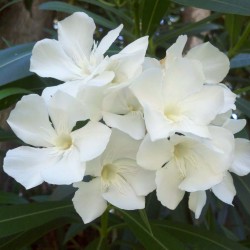
بذور الدفلى البيضاء
السعر
1.95 €
SKU: T 62 W
Seeds Gallery Com,
5/
5
<!DOCTYPE html>
<html>
<head>
<meta http-equiv="Content-Type" content="text/html; charset=UTF-8" />
</head>
<body>
<h2 dir="rtl"><strong>بذور الدفلى البيضاء</strong></h2>
<h2 dir="rtl"><span style="color: #ff0000;"><strong>ثمن حزمة من 10 بذور.</strong></span></h2>
<p dir="rtl">الدفلى أو الدفلى الزيتية (الاسم العلمي: Nerium oleander) هي نوع من النباتات تتبع جنس الدفلى من الفصيلة الدفلية. وهي نبات شديد السمية موطنه حوض البحر الأبيض المتوسط امتداداً إلى الصين.</p>
<p dir="rtl">شجيرة أو شجرة صغيرة معمرة يصل ارتفاعها إلى 2.5-6 متر، وهي ذات شكل قائم التفريع وأفرعها غزيرة ومقوسة.</p>
<p dir="rtl">الأوراق بسيطة ترتيبها سواري من 3 أوراق رمحية مطاولة ضيقة ذات قمة حادة تستدق عند القاعدة، كاملة الحواف، سميكة، سطحها العلوي أخضر داكن والسفلي أخضر باهت، مستديمة الخضرة.</p>
<p dir="rtl">الأزهار كبيرة ذات لون أبيض أو قرنفلي أو أحمر أو أرجواني، توجد في مجاميع متفرقة طرفية تظهر في المدة من نيسان/ابريل إلى تشرين الأول/أكتوبر. والثمرة جرابية متطاولة. وشديدة السمية.</p>
<p dir="rtl">منتشرة بكثرة وتناسب الزراعة في الشوارع والحدائق، وهي تصلح للزراعة في الأصص الكبيرة كما تزرع منفردة أو في مجموعات مع الشجيرات ذات الأوراق الكبيرة، وتصلح كسياج. تقلم تقليماً جائراً بعد ثالث عام. توجد في الأماكن المشمسة ونصف الظليلة، ولا تفضل الري الغزير، وتحتاج إلى تربة طينية خفيفة جيدة الصرف مسمدة بالأسمدة العضوية، تصاب بالحشرات القشرية والبق الدقيقي. وتتكاثر بالعقلة.</p>
<p dir="rtl"></p>
</body>
</html>
T 62 W


Denna anläggning är resistent mot vinter och frost. Se mer i beskrivningen.

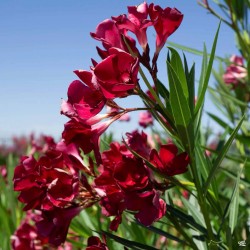
بذور الدفلى الحمراء
السعر
1.95 €
SKU: T 62 R
Seeds Gallery Com,
5/
5
<!DOCTYPE html>
<html>
<head>
<meta http-equiv="Content-Type" content="text/html; charset=UTF-8" />
</head>
<body>
<h2 dir="rtl"><strong>بذور الدفلى الحمراء</strong></h2>
<h2 dir="rtl"><span style="color: #ff0000;"><strong>ثمن حزمة من 10 بذور.</strong></span></h2>
<p dir="rtl">الدفلى أو الدفلى الزيتية (الاسم العلمي: Nerium oleander) هي نوع من النباتات تتبع جنس الدفلى من الفصيلة الدفلية. وهي نبات شديد السمية موطنه حوض البحر الأبيض المتوسط امتداداً إلى الصين.</p>
<p dir="rtl">شجيرة أو شجرة صغيرة معمرة يصل ارتفاعها إلى 2.5-6 متر، وهي ذات شكل قائم التفريع وأفرعها غزيرة ومقوسة.</p>
<p dir="rtl">الأوراق بسيطة ترتيبها سواري من 3 أوراق رمحية مطاولة ضيقة ذات قمة حادة تستدق عند القاعدة، كاملة الحواف، سميكة، سطحها العلوي أخضر داكن والسفلي أخضر باهت، مستديمة الخضرة.</p>
<p dir="rtl">الأزهار كبيرة ذات لون أبيض أو قرنفلي أو أحمر أو أرجواني، توجد في مجاميع متفرقة طرفية تظهر في المدة من نيسان/ابريل إلى تشرين الأول/أكتوبر. والثمرة جرابية متطاولة. وشديدة السمية.</p>
<p dir="rtl">منتشرة بكثرة وتناسب الزراعة في الشوارع والحدائق، وهي تصلح للزراعة في الأصص الكبيرة كما تزرع منفردة أو في مجموعات مع الشجيرات ذات الأوراق الكبيرة، وتصلح كسياج. تقلم تقليماً جائراً بعد ثالث عام. توجد في الأماكن المشمسة ونصف الظليلة، ولا تفضل الري الغزير، وتحتاج إلى تربة طينية خفيفة جيدة الصرف مسمدة بالأسمدة العضوية، تصاب بالحشرات القشرية والبق الدقيقي. وتتكاثر بالعقلة.</p>
</body>
</html>
T 62 R


Denna anläggning är resistent mot vinter och frost. Se mer i beskrivningen.
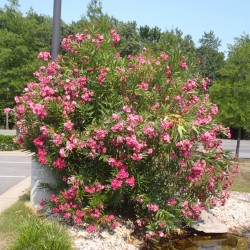
Rose Bay - Rose Laurel...
السعر
1.95 €
SKU: T 62
Seeds Gallery Com,
5/
5
<!DOCTYPE html>
<html>
<head>
<meta http-equiv="Content-Type" content="text/html; charset=UTF-8" />
</head>
<body>
<h2><span style="font-size: 14pt;"><strong>Rose Bay - Rose Laurel Seeds (Nerium oleander)</strong></span></h2>
<h2><span style="color: #ff0000; font-size: 14pt;"><strong>Price for Package of 10 seeds.</strong></span></h2>
<p>Undoubtedly a candidate for most poisonous plant in the garden but also a contender for most beautiful.</p>
<p>This species is considered to be native to Spain, the Balearic Islands and Morocco east through Mediterranean coastal countries to the Arabian Peninsula, Ethiopia, Niger, Afghanistan, Iran and Iraq to India and central China. It occurs as a non-native in parts of Africa, the Azores, Japan, Indonesia, Australia, New Zealand, the United States, central and eastern Mexico, Central and South America.</p>
<p>This species is very widely cultivated as an ornamental. All parts of the plant are poisonous and so it is not grazed or eaten. Steam from boiled leaves is inhaled to relieve sinusitis, pounded leaves are applied to the skin to relieve itching, ulcers and tumours (Jongbloed 2003); the leaves are used as an insecticide.</p>
<p>Nerium</p>
<p>Believed to come from the Greek ‘nerion’ which is, itself, believed to be based on ‘neros’, ‘wet’ or ‘fresh’.</p>
<p>oleander</p>
<p>Possibly a combination of the Latin ‘olea’, ‘olive’ and ‘rodandrum’, ‘rhododendron’ meaning the plant looks somewhat similar to a cross between these two.</p>
<p>Common Names and Synonyms</p>
<p>oleander, rose bay, common oleander, rose laurel</p>
<h2>WIKIPEDIA:</h2>
<p>Nerium oleander /ˈnɪəriəm ˈoʊliː.ændər/[3] is an evergreen shrub or small tree in the dogbane family Apocynaceae, toxic in all its parts. It is the only species currently classified in the genus Nerium. It is most commonly known as oleander, from its superficial resemblance to the unrelated olive Olea.[Note 1] It is so widely cultivated that no precise region of origin has been identified, though southwest Asia has been suggested. The ancient city of Volubilis in Morocco may have taken its name from the Berber name oualilt for the flower.[4] Oleander is one of the most poisonous commonly grown garden plants.</p>
<p><strong>Description</strong></p>
<p>Oleander grows to 2–6 m (6.6–19.7 ft) tall, with erect stems that splay outward as they mature; first-year stems have a glaucous bloom, while mature stems have a grayish bark. The leaves are in pairs or whorls of three, thick and leathery, dark-green, narrow lanceolate, 5–21 cm (2.0–8.3 in) long and 1–3.5 cm (0.39–1.38 in) broad, and with an entire margin. The flowers grow in clusters at the end of each branch; they are white, pink to red,[Note 2] 2.5–5 cm (0.98–1.97 in) diameter, with a deeply 5-lobed fringed corolla round the central corolla tube. They are often, but not always, sweet-scented.[Note 3] The fruit is a long narrow capsule 5–23 cm (2.0–9.1 in) long, which splits open at maturity to release numerous downy seeds.</p>
<p><strong>Habitat and range</strong></p>
<p>N. oleander is either native or naturalized to a broad area from Mauritania, Morocco, and Portugal eastward through the Mediterranean region and the Sahara (where it is only found sporadically), to the Arabian peninsula, southern Asia, and as far East as Yunnan in southern parts of China.[5][6][7][8] It typically occurs around dry stream beds. Nerium oleander is planted in many subtropical and tropical areas of the world. On the East Coast of the US, it grows as far north as Virginia Beach, Virginia, while in California and Texas it is naturalized as a median strip planting.[citation needed] Because of its durability, Oleander was planted prolifically on Galveston Island in Texas after the disastrous Hurricane of 1900. They are so prolific that Galveston is known as the 'Oleander City'; an annual Oleander festival is hosted every spring.[9] Oleander can be grown successfully outdoors in southern England, particularly in London and mild coastal regions of Dorset and Cornwall.</p>
<p><strong>Ecology</strong></p>
<p>Some invertebrates are known to be unaffected by oleander toxins, and feed on the plants. Caterpillars of the polka-dot wasp moth (Syntomeida epilais) feed specifically on oleanders and survive by eating only the pulp surrounding the leaf-veins, avoiding the fibers. Larvae of the common crow butterfly (Euploea core) also feed on oleanders, and they retain or modify toxins, making them unpalatable to would-be predators such as birds, but not to other invertebrates such as spiders and wasps.</p>
<p>The flowers require insect visits to set seed, and seem to be pollinated through a deception mechanism. The showy corolla acts as a potent advertisement to attract pollinators from a distance, but the flowers are nectarless and offer no reward to their visitors. They therefore receive very few visits, as typical of many rewardless flower species.[11][12] Fears of honey contamination with toxic oleander nectar are therefore unsubstantiated.</p>
<p><strong>Ornamental gardening</strong></p>
<p>Oleander is a vigorous grower in warm subtropical regions, where it is extensively used as an ornamental plant in parks, along roadsides, and as a windbreak. It will tolerate occasional light frost down to −10 °C (14 °F).,[8] though the leaves may be damaged. The toxicity of Oleander renders it deer-resistant. The plant is tolerant of poor soils, salt spray, and sustained drought, although it will flower and grow more vigorously with regular water. Nerium Oleander also responds well to heavy pruning, which should be done in the autumn or early spring to keep plants from becoming unruly.</p>
<p>In cold-winter climates Oleander can be grown in greenhouses and conservatories, or as potted indoor plants that can be kept outside in the summer. Oleander flowers are showy, profuse, and often fragrant, which makes them very attractive in many contexts. Over 400 cultivars have been named, with several additional flower colors not found in wild plants having been selected, including red, pink, yellow, and salmon; white and a variety of pinks are the most common. Double flowered cultivars like 'Mrs Isadore Dyer' or 'Mont Blanc' are enjoyed for their large, rose-like blooms and strong fragrance. Many dwarf cultivars have also been developed, which grow only to about 10' at maturity. In most Mediterranean climates they can be expected to bloom from April through October, with their heaviest bloom usually in May or June.</p>
<p><strong>Toxicity</strong></p>
<p>Oleander has historically been considered a poisonous plant because some of its compounds may exhibit toxicity, especially to animals, when consumed in large amounts. Among these compounds are oleandrin and oleandrigenin, known as cardiac glycosides, which are known to have a narrow therapeutic index and can be toxic when ingested.</p>
<p>Toxicity studies of animals administered oleander extract concluded that rodents and birds were observed to be relatively insensitive to oleander cardiac glycosides.[16] Other mammals, however, such as dogs and humans, are relatively sensitive to the effects of cardiac glycosides and the clinical manifestations of "glycoside intoxication".</p>
<p>However, despite the common "poisonous" designation of this plant, very few toxic events in humans have been reported. According to the Toxic Exposure Surveillance System, in 2002, 847 human exposures to oleander were reported to poison centers in the United States.[19] Despite this exposure level, from 1985 through 2005, only three deaths were reported. One cited death was apparently due to the ingestion of oleander leaves by a diabetic man.[20] His blood indicated a total blood concentration of cardiac glycosides of about 20 μg/l, which is well above the reported fatal level. Another study reported on the death of a woman who self-administered "an undefined oleander extract" both orally and rectally and her oleandrin tissue levels were 10 to 39 μg/g, which were in the high range of reported levels at autopsy.[21] And finally, one study reported the death of a woman who ingested oleander 'tea'.[22] Few other details were provided.</p>
<p>In contrast to consumption of these undefined oleander-derived materials, no toxicity or deaths were reported from topical administration or contact with N. oleander or specific products derived from them. In reviewing oleander toxicity, Lanford and Boor[23] concluded that, except for children who might be at greater risk, "the human mortality associated with oleander ingestion is generally very low, even in cases of moderate intentional consumption (suicide attempts)".</p>
<p>Toxicity studies conducted in dogs and rodents administered oleander extracts by intramuscular injection indicated that, on an equivalent weight basis, doses of an oleander extract with glycosides 10 times those likely to be administered therapeutically to humans are still safe and without any "severe toxicity observed".</p>
<p>In South Indian states such as Tamil Nadu and in Sri Lanka the seeds of related plant with similar local name (Kaneru(S) කණේරු) Cascabela thevetia produce a poisonous plum with big seeds. As these seeds contain cardenolides, swallowing them is one of the preferred methods for suicides in villages.</p>
<p><strong>Effects of poisoning</strong></p>
<p>Ingestion of this plant can affect the gastrointestinal system, the heart, and the central nervous system. The gastrointestinal effects can consist of nausea and vomiting, excess salivation, abdominal pain, diarrhea that may contain blood, and especially in horses, colic.[7] Cardiac reactions consist of irregular heart rate, sometimes characterized by a racing heart at first that then slows to below normal further along in the reaction. Extremities may become pale and cold due to poor or irregular circulation. The effect on the central nervous system may show itself in symptoms such as drowsiness, tremors or shaking of the muscles, seizures, collapse, and even coma that can lead to death.</p>
<p>Oleander sap can cause skin irritations, severe eye inflammation and irritation, and allergic reactions characterized by dermatitis.</p>
<p><strong>Treatment</strong></p>
<p>Poisoning and reactions to oleander plants are evident quickly, requiring immediate medical care in suspected or known poisonings of both humans and animals.[25] Induced vomiting and gastric lavage are protective measures to reduce absorption of the toxic compounds. Charcoal may also be administered to help absorb any remaining toxins.[7] Further medical attention may be required depending on the severity of the poisoning and symptoms. Temporary cardiac pacing will be required in many cases (usually for a few days) until the toxin is excreted.</p>
<p>Digoxin immune fab is the best way to cure an oleander poisoning if inducing vomiting has no or minimal success, although it is usually used only for life-threatening conditions due to side effects.</p>
<p>Drying of plant materials does not eliminate the toxins. It is also hazardous for animals such as sheep, horses, cattle, and other grazing animals, with as little as 100 g being enough to kill an adult horse.[26] Plant clippings are especially dangerous to horses, as they are sweet. In July 2009, several horses were poisoned in this manner from the leaves of the plant.[27] Symptoms of a poisoned horse include severe diarrhea and abnormal heartbeat. There is a wide range of toxins and secondary compounds within oleander, and care should be taken around this plant due to its toxic nature. Different names for oleander are used around the world in different locations, so, when encountering a plant with this appearance, regardless of the name used for it, one should exercise great care and caution to avoid ingestion of any part of the plant, including its sap and dried leaves or twigs. The dried or fresh branches should not be used for spearing food, for preparing a cooking fire, or as a food skewer. Many of the oleander relatives, such as the desert rose (Adenium obesum) found in East Africa, have similar leaves and flowers and are equally toxic.</p>
<p><strong>Folklore</strong></p>
<p>The alleged toxicity of the plant makes it the center of an urban legend documented on several continents and over more than a century. Often told as a true and local event, typically an entire family, or in other tellings a group of scouts, succumbs after consuming hot dogs or other food roasted over a campfire using oleander sticks.</p>
<p><strong>Garden history</strong></p>
<p>In his book Enquiries into Plants of circa 300 BC, Theophrastus described (among plants that affect the mind) a shrub he called onotheras, which modern editors render oleander; "the root of onotheras [oleander] administered in wine", he alleges, "makes the temper gentler and more cheerful".</p>
<p>The plant has a leaf like that of the almond, but smaller, and the flower is red like a rose. The plant itself (which loves hilly country) forms a large bush; the root is red and large, and, if this is dried, it gives off a fragrance like wine.</p>
<p>In another mention, of "wild bay" (Daphne agria), Theophrastus appears to intend the same shrub.</p>
<p>Oleander was a very popular ornamental shrub in Roman peristyle gardens; it is one of the flora most frequently depicted on murals in Pompeii and elsewhere in Italy. These murals include the famous garden scene from the House of Livia at Prima Porta outside Rome, and those from the House of the Wedding of Alexander and the Marine Venus in Pompeii.</p>
<p>Willa Cather, in her book The Song of the Lark, mentions oleander in this passage:</p>
<p>This morning Thea saw to her delight that the two oleander trees, one white and one red, had been brought up from their winter quarters in the cellar. There is hardly a German family in the most arid parts of Utah, New Mexico, Arizona, but has its oleander trees. However loutish the American-born sons of the family may be, there was never one who refused to give his muscle to the back-breaking task of getting those tubbed trees down into the cellar in the fall and up into the sunlight in the spring. They may strive to avert the day, but they grapple with the tub at last.</p>
<p>Oleander is the official flower of the city of Hiroshima, having been the first to bloom following the atomic bombing of the city in 1945.</p>
<p>It is the provincial flower of Sindh province.</p>
</body>
</html>
T 62 P

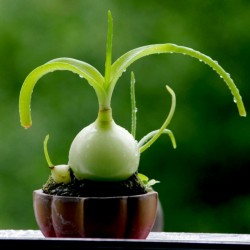
بذور بصل البحر (Albuca...
السعر
3.80 €
SKU: CT 23
Seeds Gallery Com,
5/
5
<!DOCTYPE html>
<html>
<head>
<meta http-equiv="Content-Type" content="text/html; charset=UTF-8" />
</head>
<body>
<h2 dir="rtl"><strong>بذور بصل البحر (Albuca bracteata) </strong></h2>
<h2 dir="rtl"><strong><span style="color: #ff0000;">ثمن عبوة من 3 بذور.</span> </strong></h2>
<p dir="rtl">يُعرف Albuca bracteata (syn. Ornithogalum longebracteatum) بالأسماء الشائعة البصل الحامل ، بصل البحر الكاذب ، وبصل البحر. إنه نوع من النباتات المزهرة منتفخة في عائلة Asparagaceae. يمكن أن يصل ارتفاع السيقان المزهرة إلى 90 سم ويمكن أن تحمل ما يصل إلى 100 زهرة بيضاء مخضرة.</p>
<p dir="rtl">أوراق لانسولات على شكل شريط ، طولها 60 سم (2 قدم) وعرضها 2.5 سم (1 بوصة) ، تبرز من لمبة كبيرة الحجم تقع بشكل كبير فوق الأرض. الجذور بيضاء ونضرة. توجد العديد من الأزهار البيضاء الصغيرة المعطرة التي يبلغ قطرها 0.5 سم ووسطها الأخضر على أعراق يمكن أن يصل ارتفاعها إلى 70-90 سم. عادة ما يحدث الإزهار من الربيع وحتى أوائل الشتاء (مايو إلى أغسطس في نصف الكرة الشمالي) ، مع 50 إلى 100 زهرة لكل ساق. يمكن أن يحتوي النبات الواحد على 300 زهرة في وقت واحد. يبلغ طول كبسولات الفاكهة 10 ملم وقطرها 6 ملم. البذور مستطيلة بأبعاد 4 × 1.5 مم. Albuca bracteata هو نبات كريبتوفيت ، حيث تموت أوراق الشجر مرة أخرى خلال فترات الجفاف.</p>
<p dir="rtl">غالبًا ما يُزرع كنبات للزينة. النبات قابل للتكيف للغاية وبالتالي فهو مثالي للنمو في الحاويات. يفضل أشعة الشمس المباشرة. يجب أن تكون الركيزة جيدة التصريف.</p>
<p dir="rtl">تحمل درجات حرارة تصل إلى -5 درجة مئوية.</p>
<p dir="rtl">في الطب ، تُستخدم أوراق النبات المطحونة لعلاج الجروح والكدمات. وفقًا لبعض المصادر ، فإن التأثير الطبي لهذا النبات يشبه تأثير الألوة فيرا.</p>
</body>
</html>
CT 23 (3 S)


هذا النبات له ثمار عملاقة
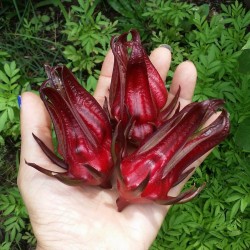
بذور الكركديه العملاقة...
السعر
3.50 €
SKU: MHS 19 G
Seeds Gallery Com,
5/
5
<div>
<h2 dir="rtl" class=""><strong>بذور الكركديه العملاقة (Hibiscus sabdariffa)</strong></h2>
<h2 dir="rtl"><span style="color: #ff0000;" class=""><strong>ثمن عبوة من 5 بذور.</strong></span></h2>
<p dir="rtl"><strong><span style="color: #000000; font-size: 18px;">ثمار هذا الكركديه أكبر بمرتين من أي كركديه أخرى.</span></strong><br>The roselle (Hibiscus sabdariffa) is a species of Hibiscus native to the Old World tropics, used for the production of bast fibre and as<br>an infusion. It is an annual or perennial herb or woody-based subshrub, growing to 2–2.5 m (7–8 ft) tall. The leaves are deeply three- to five-lobed, 8–15 cm (3–6 in) long, arranged alternately on the stems.</p>
</div>
<p dir="rtl">The flowers are 8–10 cm (3–4 in) in diameter, white to pale yellow with a dark red spot at the base of each petal, and have a stout fleshy calyx at the base, 1–2 cm (0.39–0.79 in) wide, enlarging to 3–3.5 cm (1.2–1.4 in), fleshy and bright red as the fruit matures. It takes about six months to mature.</p>
<p dir="rtl"><span><strong>Names</strong></span></p>
<p dir="rtl"><span>The roselle is known as the rosella or rosella fruit in Australia. It is also known as 'Belchanda' among Nepalese, Tengamora among Assamese and "mwitha" among Bodo tribals in Assam, চুকর Chukor in Bengali, Gongura in Telugu, Pundi in Kannada, Ambadi in Marathi, LalChatni or Kutrum in Mithila] Mathipuli in Kerala, chin baung in Burma, กระเจี๊ยบแดง KraJiabDaeng in Thailand, ສົ້ມ ພໍດີ som phor dee in Lao PDR, bissap in Senegal, Guinea Bissau, Mali, Burkina Faso, Ghana, Benin and Niger, the Congo and France, dah or dah bleni in other parts of Mali, wonjo in the Gambia, zobo in western Nigeria (the Yorubas in Nigeria call the white variety Isapa (pronounced Ishapa)), Zoborodo in Northern Nigeria, Chaye-Torosh in Iran, karkade (كركديه; Arabic pronunciation: [ˈkarkade])[dubious – discuss] in Egypt, Saudi Arabia, and Sudan, omutete in Namibia, sorrel in the Caribbean and in Latin America, Flor de Jamaica in Mexico, Saril in Panama, grosella in Paraguay and vinagreira, caruru-azedo or quiabo-roxo in Brazil. Rosela in Indonesia, asam belanda[1] in Malaysia. In Chinese it is 洛神花 (Luo Shen Hua) . In Zambia the plant is called lumanda in ciBemba, katolo in kiKaonde, or wusi in chiLunda.</span></p>
<p dir="rtl"><span><strong>Uses</strong></span></p>
<p dir="rtl"><span>The plant is considered to have antihypertensive properties. In some places, the plant is primarily cultivated for the production of bast fibre from the stem of the plant. The fibre may be used as a substitute for jute in making burlap.[2] Hibiscus, specifically Roselle, has been used in folk medicine as a diuretic, mild laxative, and treatment for cardiac and nerve diseases and cancer.[3]</span></p>
<p dir="rtl"><span>The red calyces of the plant are increasingly exported to America and Europe, where they are used as food colourings. Germany is the main importer. It can also be found in markets (as flowers or syrup) in some places such as France, where there are Senegalese immigrant communities. The green leaves are used like a spicy version of spinach. They give flavour to the Senegalese fish and rice dish thiéboudieune. Proper records are not kept, but the Senegalese government estimates national production and consumption at 700 t (770 short tons) per year. Also in Burma their green leaves are the main ingredient in making chin baung kyaw curry.</span></p>
<p dir="rtl"><span>In East Africa, the calyx infusion, called "Sudan tea", is taken to relieve coughs. Roselle juice, with salt, pepper, asafoetida and molasses, is taken as a remedy for biliousness.</span></p>
<p dir="rtl"><span>The heated leaves are applied to cracks in the feet and on boils and ulcers to speed maturation. A lotion made from leaves is used on sores and wounds. The seeds are said to be diuretic and tonic in action and the brownish-yellow seed oil is claimed to heal sores on camels. In India, a decoction of the seeds is given to relieve dysuria, strangury and mild cases of dyspepsia. Brazilians attribute stomachic, emollient and resolutive properties to the bitter roots.[4]</span></p>
<p dir="rtl"><span><strong>Leafy vegetable/Greens</strong></span></p>
<p dir="rtl"><span>In Andhra cuisine, Hibiscus cannabinus, called Gongura, is extensively used. The leaves are steamed along with lentils and cooked with Dal. The other unique dish prepared is gongura pachadi, it is prepared by mixing fried leaves with spices and made into a Gongura Pacchadi, the most famous dish of Andhra cuisine and is often described as king of all foods of Andhra ethnics(andhrulu)</span></p>
<p dir="rtl"><span>In Burmese cuisine, called chin baung ywet (lit. sour leaf), the roselle is widely used and considered an affordable vegetable for the population. It is perhaps the most widely eaten and popular vegetable in Burma.[5] The leaves are fried with garlic, dried or fresh prawns and green chili or cooked with fish. A light soup made from roselle leaves and dried prawn stock is also a popular dish.</span></p>
<p dir="rtl"><span><strong>Beverage</strong></span></p>
<p dir="rtl"><span>Cuisine: Among the Bodo tribals of Bodoland, Assam (India) the leaves of both hibiscus sabdariffa and hibiscus cannabinus are cooked along with chicken, fish or pork, one of their traditional cuisines</span></p>
<p dir="rtl"><span>In the Caribbean sorrel drink is made from sepals of the roselle. In Malaysia, roselle calyces are harvested fresh to produce pro-health drink due to high contents of vitamin C and anthocyanins. In Mexico, 'agua de Flor de Jamaica' (water flavored with roselle) frequently called "agua de Jamaica" is most often homemade. Also, since many untrained consumers mistake the calyces of the plant to be dried flowers, it is widely, but erroneously, believed that the drink is made from the flowers of the non-existent "Jamaica plant". It is prepared by boiling dried sepals and calyces of the Sorrel/Flower of Jamaica plant in water for 8 to 10 minutes (or until the water turns red), then adding sugar. It is often served chilled. This is also done in Saint Kitts and Nevis, Guyana, Antigua, Barbados, St. Lucia, Dominica, Grenada, Jamaica and Trinidad and Tobago where it is called 'sorrel'. The drink is one of several inexpensive beverages (aguas frescas) commonly consumed in Mexico and Central America, and they are typically made from fresh fruits, juices or extracts. A similar thing is done in Jamaica but additional flavor is added by brewing the tea with ginger and adding rum. It is a popular drink of the country at Christmas time. It is also very popular in Trinidad & Tobago but cinnamon, cloves and bay leaves are preferred to ginger. In Mali, Senegal, The Gambia, Burkina Faso and Benin calyces are used to prepare cold, sweet drinks popular in social events, often mixed with mint leaves, dissolved menthol candy, and/or various fruit flavors. The Middle Eastern and Sudanese drink "Karkade"(كركديه) is a cold drink made by soaking the dried Karkade flowers in cold water over night in a refrigerator with sugar and some lemon or lime juice added.It is then consumed with or without ice cubes after the flowers have been strained.In Lebanon, sometimes toasted pine nuts are tossed into the drink.</span></p>
<p dir="rtl"><span>With the advent in the U.S. of interest in south-of-the-border cuisine, the calyces are sold in bags usually labeled "Flor de Jamaica" and have long been available in health food stores in the U.S. for making a tea that is high in vitamin C. This drink is particularly good for people who have a tendency, temporary or otherwise, toward water retention: it is a mild diuretic.</span></p>
<p dir="rtl"><span>In addition to being a popular homemade drink, Jarritos, a popular brand of Mexican soft drinks, makes a Flor de Jamaica flavored carbonated beverage. Imported Jarritos can be readily found in the U.S.</span></p>
<p dir="rtl"><span>In the UK the dried calyces and ready-made sorrel syrup are widely and cheaply available in Caribbean and Asian grocers. The fresh calyces are imported mainly during December and January in order to make Christmas and New Year infusions, which are often made into cocktails with additional rum. They are very perishable, rapidly developing fungal rot, and need to be used soon after purchase – unlike the dried product, which has a long shelf-life.</span></p>
<p dir="rtl"><span>In Africa, especially the Sahel, roselle is commonly used to make a sugary herbal tea that is commonly sold on the street. The dried flowers can be found in every market. Roselle tea is also quite common in Italy where it spread during the first decades of the 20th century as a typical product of the Italian colonies. The Carib Brewery Trinidad Limited, a Trinidad and Tobago brewery, produces a Shandy Sorrel in which the tea is combined with beer.</span></p>
<p dir="rtl"><span>In Thailand, Roselle is generally drunk as a cool drink,[6] but also as a tea, believed to also reduce cholesterol. It can also be made into a wine.</span></p>
<p dir="rtl"><span>Hibiscus flowers are commonly found in commercial herbal teas, especially teas advertised as berry-flavoured, as they give a bright red colouring to the drink.</span></p>
<p dir="rtl"><span>Rosella flowers are sold as Wild Hibiscus flowers in syrup in Australia as a gourmet product. Recipes include filling them with goats cheese, serving them on baguette slices baked with brie, & placing one plus a little syrup, in a champagne flute before adding the champagne when the bubbles cause the flower to open.</span></p>
<p dir="rtl"><span><strong>Jam and preserves</strong></span></p>
<p dir="rtl"><span>In Nigeria, rosella jam has been made since Colonial times and is still sold regularly at community fetes and charity stalls. It is similar in flavour to plum jam, although more acidic. It differs from other jams in that the pectin is obtained from boiling the interior buds of the rosella flowers. It is thus possible to make rosella jam with nothing but rosella buds and sugar. Roselle is also used in Nigeria to make a refreshing drink known as Zobo.</span></p>
<p dir="rtl"><span>In Burma, the buds of the roselle are made into 'preserved fruits' or jams. Depending on the method and the preference, the seeds are either removed or included. The jams, made from roselle buds and sugar, are red and tangy.</span></p>
<p dir="rtl"><span>"Sorrel jelly" is manufactured in Trinidad.</span></p>
<p dir="rtl"><span>Rosella Jam is also made in Queensland, Australia as a home-made or speciality product sold at fetes and other community events.[7]</span></p>
<p dir="rtl"><span><strong>Medicinal uses</strong></span></p>
<p dir="rtl"><span>Many parts of the plant are also claimed to have various medicinal values. They have been used for such purposes ranging from Mexico through Africa and India to Thailand. Roselle is associated with traditional medicine and is reported to be used as treatment for several diseases such as hypertension and urinary tract infections.[8]</span></p>
<p dir="rtl"><span>Although Roselle has well documented hypotensive effects,[9] there is currently insufficient evidence to support the benefit of Roselle for either controlling or lowering blood pressure due to a lack of well designed studies that measure the efficacy of Roselle on patients with hypertension.[10]</span></p>
<p dir="rtl"><span>A double blind, placebo controlled, randomized trial was conducted to determine the effect of Roselle leaf extract on a group of 60 subjects with serum LDL values in the range of 130-190 ml/dl (<130 ml/dl is a goal value for most patients[11]) and no history of coronary heart disease. The experimental group received 1g of Roselle leaf extract while the placebo group received a similar amount of maltodextrin in addition to dietary and physical activity advice. Both groups had decreases in body weight, LDL cholesterol, and triglycerides that can likely be attributed to the dietary and physical activity advice. At a dose of 1g/day, Roselle leaf extract did not appear to have a blood lipid lowering effect.[12]</span></p>
<p dir="rtl"><span>Hibiscus sabdariffa has shown in vitro antimicrobial activity against E. coli.[13] A recent review stated that specific extracts of H. sabdariffa exhibit activities against atherosclerosis, liver disease, cancer, diabetes and other metabolic syndromes.</span></p>
<p dir="rtl"><span><strong>Phytochemicals</strong></span></p>
<p dir="rtl"><span>The plants are rich in anthocyanins, as well as protocatechuic acid. The dried calyces contain the flavonoids gossypetin, hibiscetine and sabdaretine. The major pigment, formerly reported as hibiscin, has been identified as daphniphylline. Small amounts of myrtillin (delphinidin 3-monoglucoside), Chrysanthenin (cyanidin 3-monoglucoside), and delphinidin are also present. Roselle seeds are a good source of lipid-soluble antioxidants, particularly gamma-tocopherol.[15]</span></p>
<p dir="rtl"> </p>
<p dir="rtl"><span><strong>Production</strong></span></p>
<p dir="rtl"><span>China and Thailand are the largest producers and control much of the world supply. Thailand invested heavily in roselle production and their product is of superior quality, whereas China's product, with less stringent quality control practices, is less reliable and reputable. The world's best roselle comes from the Sudan, but the quantity is low and poor processing hampers quality. Mexico, Egypt, Senegal, Tanzania, Mali and Jamaica are also important suppliers but production is mostly used domestically.[16]</span></p>
<p dir="rtl"><span>In the Indian subcontinent (especially in the Ganges Delta region), roselle is cultivated for vegetable fibres. Roselle is called meśta (or meshta, the ś indicating an sh sound) in the region. Most of its fibres are locally consumed. However, the fibre (as well as cuttings or butts) from the roselle plant has great demand in various natural fibre using industries.</span></p>
<p dir="rtl"><span>Roselle is a relatively new crop to create an industry in Malaysia. It was introduced in early 1990s and its commercial planting was first promoted in 1993 by the Department of Agriculture in Terengganu. The planted acreage was 12.8 ha (30 acres) in 1993, but had steadily increased to peak at 506 ha (1,000 acres) in 2000. The planted area is now less than 150 ha (400 acres) annually, planted with two main varieties.[citation needed] Terengganu state used to be the first and the largest producer, but now the production has spread more to other states. Despite the dwindling hectarage over the past decade or so, roselle is becoming increasingly known to the general population as an important pro-health drink in the country. To a small extent, the calyces are also processed into sweet pickle, jelly and jam. jimmon rubillos</span></p>
<p dir="rtl"><span><strong>Crop research</strong></span></p>
<p dir="rtl"><span>In the initial years, limited research work were conducted by University Malaya (UM) and Malaysian Agricultural Research and Development Institute (MARDI). Research work at Universiti Kebangsaan Malaysia (UKM) was initiated in 1999. In many respect, the amount of research work is still considered meagre in supporting a growing roselle industry in Malaysia.</span></p>
<p dir="rtl"><span>Crop genetic resources & improvement[edit]</span></p>
<p dir="rtl"><span>Genetic variation is important for plant breeders to increase the crop productivity. Being an introduced species in Malaysia, there is a very limited number of germplasm accessions available for breeding. At present, UKM maintains a working germplasm collection, and also conducts agronomic research and crop improvement.</span></p>
<p dir="rtl"><span>Mutation breeding[edit]</span></p>
<p dir="rtl"><span>Genetic variation is important for plant breeders to increase its productivity. Being an introduced crop species in Malaysia, there is a limited number of germplasm accessions available for breeding. Furthermore, conventional hybridization is difficult to carry out in roselle due to its cleistogamous nature of reproduction. Because of this, a mutation breeding programme was initiated to generate new genetic variability.[17] The use of induced mutations for its improvement was initiated in 1999 in cooperation with MINT (now called Malaysian Nuclear Agency), and has produced some promising breeding lines. Roselle is a tetraploid species; thus, segregating populations require longer time to achieve fixation as compared to diploid species. In April 2009, UKM launched three new varieties named UKMR-1, UKMR-2 and UKMR-3, respectively. These three new varieties were developed using variety Arab as the parent variety in a mutation breeding programme which started in 2006.</span></p>
<p dir="rtl"><span><strong>Natural outcrossing under local conditions</strong></span></p>
<p dir="rtl"><span>A study was conducted to estimate the amount of outcrossing under local conditions in Malaysia. It was found that outcrossing occurred at a very low rate of about 0.02%. However, this rate is much lower in comparison to estimates of natural cross-pollination of between 0.20% and 0.68% as reported in Jamaica.</span></p>
<p dir="rtl"><span><strong>Source: Wikipedia</strong></span></p>
MHS 19 G (5 S)

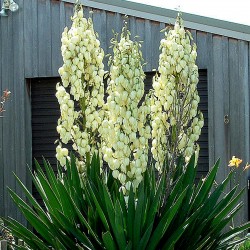
(Yucca filamentosa) يكة...
السعر
2.35 €
SKU: CT 8
Seeds Gallery Com,
5/
5
<h2 dir="rtl" class=""><strong>(Yucca filamentosa) يكة خيطية بذور</strong></h2>
<h2><span style="color: #ff0000;"><strong>ثمن عبوة من 5 بذور.</strong></span></h2>
عادة ما تكون بلا جذع ، فهي متعددة الملاقط برؤوس بطول 75 سم (30 بوصة) ، خيطية ، خضراء مزرقة ، أوراق ضيقة. يتم تمييز Y. filamentosa بسهولة عن أنواع اليوكا الأخرى بواسطة خيوط بيضاء سريعة على طول هوامش الأوراق. ينبع الزهرة حتى ارتفاع 3 أمتار (10 أقدام) من أزهار الكريمة المتدلية في أوائل الصيف. يتم تلقيحها بواسطة عثة اليوكا Tegeticula yuccasella. أنواع العث الأخرى ، مثل Tegeticula intermedia ، تستخدم هذا اليوكا أيضًا كنبات مضيف لوضع بيضها.<br /><br />الاستخدامات<br /><br />بمجرد إزالة البذور ، يمكن طهي الثمار وتناولها. يمكن أيضًا تناول بتلات الزهور الكبيرة في السلطات.<br /><br />يمكن استخدام أوراق وسيقان وجذور هذا النبات لصعق الأسماك. استخدمها الشيروكي لهذا الغرض.
CT 8 (5 S)





